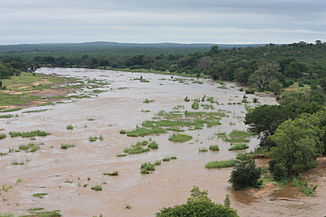Lepelle
|
Lepelle Olifants River, Olifantsrivier, Rio dos Elefantes |
||
|
The catchment area of the Limpopo with the "Olifants" (bottom middle) |
||
| Data | ||
| location |
( Mpumalanga Province ) Mozambique |
|
| River system | Limpopo | |
| Drain over | Limpopo → Indian Ocean | |
| source | north of Ermelo (South Africa) 26 ° 20 ′ 33 ″ S , 29 ° 49 ′ 47 ″ E |
|
| Source height | 1762 m | |
| muzzle | in Limpopo coordinates: 24 ° 6 ′ 41 ″ S , 32 ° 38 ′ 20 ″ E 24 ° 6 ′ 41 ″ S , 32 ° 38 ′ 20 ″ E |
|
| Mouth height | 53 m | |
| Height difference | 1709 m
|
|
| Catchment area | 70,000 km² | |
| Outflow A Eo : 54,308 km² |
MNQ MQ Mq MHQ |
15.2 m³ / s 64.7 m³ / s 1.2 l / (s km²) 157.8 m³ / s |
| Runoff (1,644 million m³ / year) |
MQ |
52.13 m³ / s |
| Left tributaries | Elands River , Mphongolo , Shingwedzi | |
| Right tributaries | Tubatse , Klein Olifants River | |
| Reservoirs flowed through | Witbank Dam , Loskop Dam , Flag Boshielo Dam , Massingir Dam | |
|
The Olifants River as it flows through the Kruger National Park |
||
The Lepelle (until 2005 Olifants River or Olifantsrivier ) is a river that has its source in the South African province of Mpumalanga .
course
It flows north through the Witbank Dam and the Loskop Dam . In the Transvaal the Transvaal-Drakensberg force him to the east; it cuts through the Abel-Erasmus pass , flows eastward and joins the Letaba . When crossing the border to Mozambique , it changes its name to Rio dos Elefantes and flows into the Limpopo , which still receives the Rio Changane before it flows into the Indian Ocean at Xai-Xai north of Maputo .
Hydrometry
The flow rate of the Lepelle was measured at 54,300 km² of 70,000 km² in m³ / s.

Web links
swell
- Can the Olifants River still be saved? on www.csir.co.za (English)
Individual evidence
- ^ A b Drought impact mitigation and prevention in the Limpopo River Basin. A situation analysis. In: Land and Water Discussion Paper. FAO Natural Resources Management and Environment Department, 2004, p. “Water Resources” , accessed April 26, 2010 .
- ^ A b Hydrological Review of the Olifants River Catchment
- ↑ Old PlaceNames ( English ) Department of Arts and Culture. Archived from the original on February 8, 2010. Retrieved December 28, 2015.

